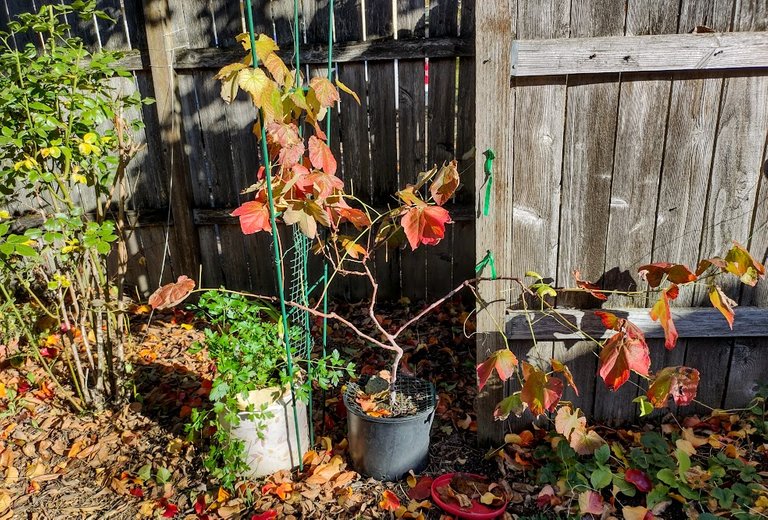
Container plants must be replanted from time to time. By inspecting the plant roots, we best see what is happening under the surface of the soil, as this is the area that matters most after all the leaves have fallen in early winter.
Introduction
Here in this article, I will be detailing the process of replanting a large grapevine that has been growing in a container. I'll discuss methods that work well to ensure that that the vine will live healthy for a long time.
Proactive Root Management
All tree-like plants growing in a container well tend to have poorer health than those grown in the earth, because nature normally nurtures the roots in ways a pot cannot. The wise gardener must inspect the pot-bound plant to assess, and then manage its needs manually.
For a fruiting plant, it is especially important to keep the roots of a container plant well managed.
Proactive appropriate management of the roots will increase the lifespan of the plant, as well as the flavor, size, and amount of fruit to be harvested for all future years.
October 30, 2021
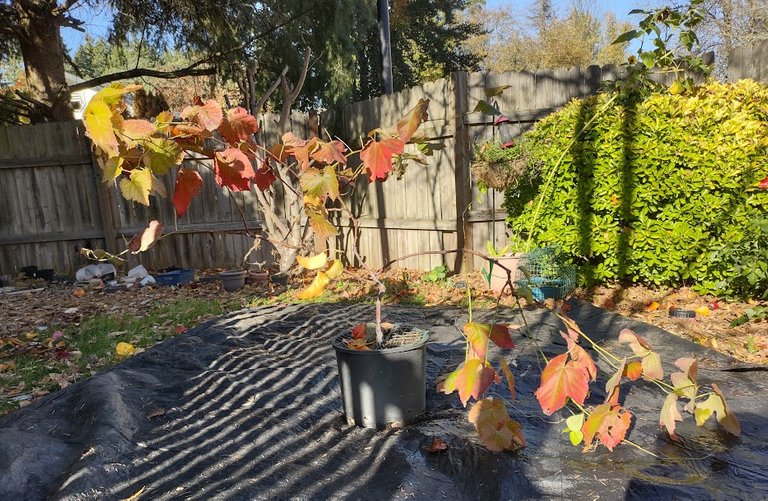
This is my grapevine. The variety is called "Venus". This tree, I've nicknamed it Aphrodite, the Greek version of the same name.
It has never been replanted in the five and a half years since I first planted it in this large plastic pot.
This could potentially be a big mess when I tip it out. The black tarp comes in handy to keep the grounds cleaner for this project. Ideally, the rootball and soil will come out in one piece, but the soil is very heavy and slightly waterlogged even after a few weeks of dry weather.
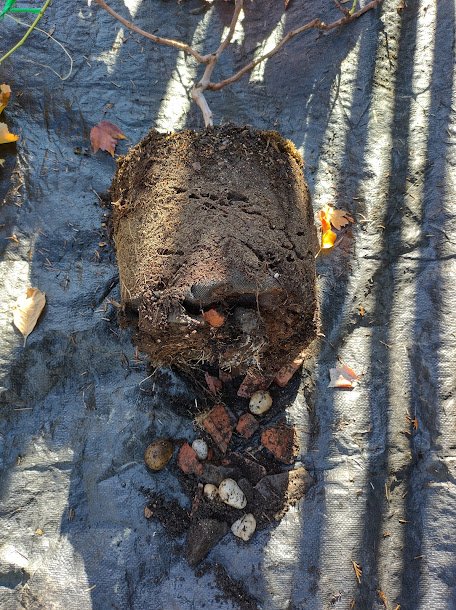
Releasing A Heavy Rootball
Using my garden knife, the handy hori hori, I was able to cut around the root ball, and slide everything out mostly in one piece. The top of the tree is extremely brittle, so I had to choose a side of the tree that seemed the strongest and flattest to lay the tree down sideways (an #Espalier shape for branches tends to make replanting much easier too).
Thankfully the trunk and main branches did not suffer any breakage today. Broken limbs at this point could stress the tree, ruin its form, and possibly result in years lost of potential fruit yields. The current branches, I prefer not to prune anything woody until late January or February.
Root Assessment
Overall, the root system looks much cleaner than I was expecting. Roots have clustered slightly at the base in the center. Few roots around the base, likely thanks to the heavy drainage layer.
The sandy layers have done a good job of holding the structure of the roots in place, but clearly does not promote any soil fertility. A thick mulch layer on top is providing a soft moisture barrier along with nutrients to trickle down into the rootball. I am guessing many feeder roots and beneficial fungi exist in this top layer.
All is developing according to my plan, with the soil design I originally established. Woody Mulch / Sand and Soil / Rock and Air.
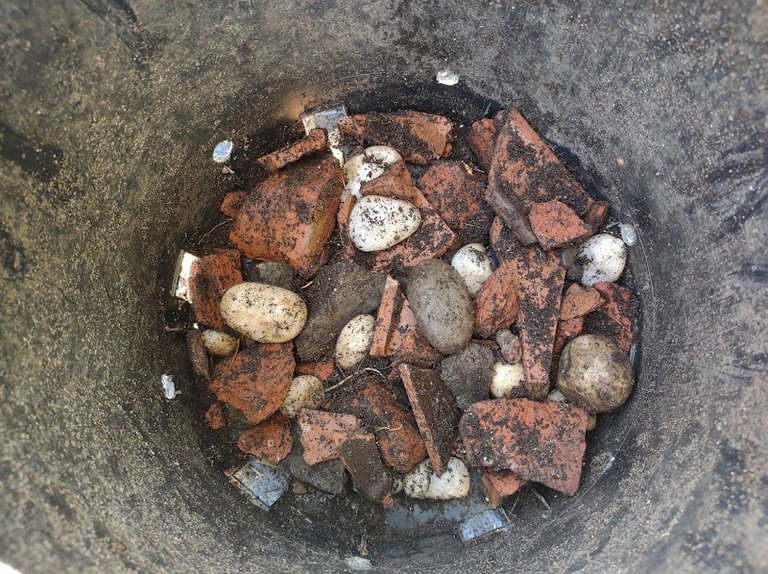
Fast Drainage
The drainage layer can be reused quite easily. Mostly round river stones, broken pottery, and perhaps a few pieces of red brick. By using smooth, blocky pieces, large air pockets exist to help prevent roots from escaping. Large rocks also prevent puddling and rot related diseases. The large square side holes, I dam them up as much as possible by pushing the rocks up against them.
In the photos above, you might also notice I have a screen layer between the sandy soil and the rocks. This also helps prevent the soil from filling into the rock layer. This screen does tend to get tangled with new young roots though, so care must be taken not to disturb those roots too much when removing and replacing the screen to the base of the soil.
Additional smaller round holes underneath and on the sides also exist. This pot will never flood.
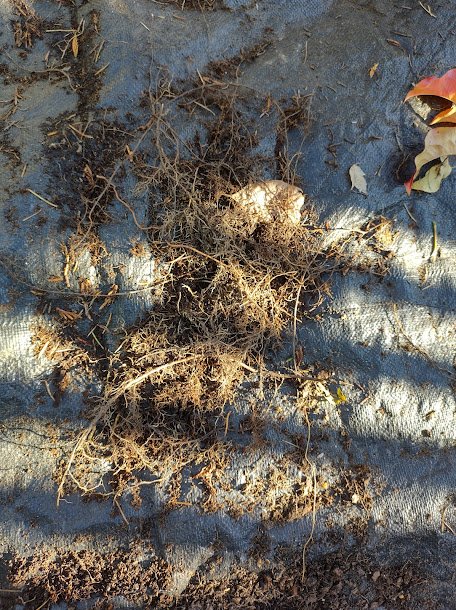
Pruning
Any clustered roots at the base or sides, or long roots winding around the perimeter of the root ball are trimmed off. There really wasn't anything major trimmed. The thickest roots were no thicker than a spaghetti noodle. Any blackened dead roots can also be plucked off, but I didn't find many signs of dead roots.
Without washing off the soil completely from the root ball, it is hard to determine what percent of the roots I have removed. Going bare-root will stress the plant more than I think is necessary for removing so little. I make a gamble and a guess that since these roots would fill no more than a couple quarts (10% of the rootmass?), it should be far within a safe amount to remove compared to the multi-gallon sized soil and rootball remaining.
Additional Root Control
On a plant like this that has vigorous, invasive root systems, I have always been very careful to keep the roots separated from the earth, to prevent it from sprawling out the below. A simple concrete paver underneath the pot ensures solid impermeable layer to block any searcher roots from escaping out.
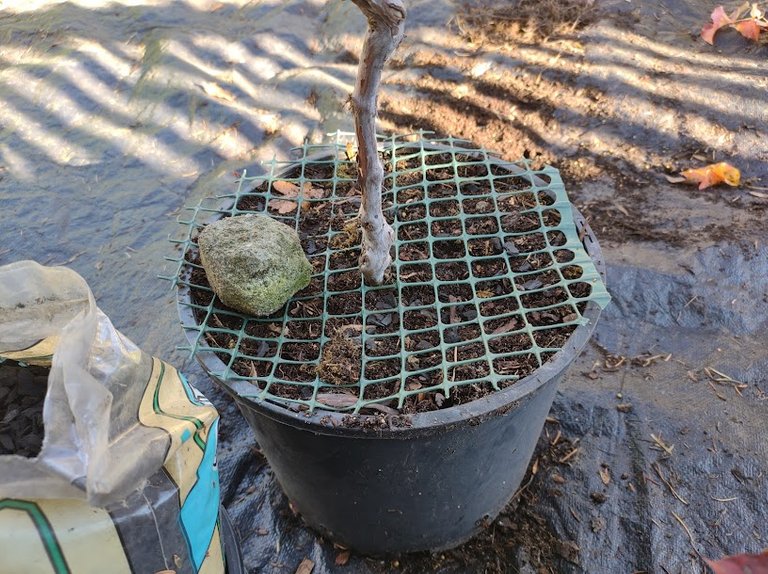
Replanting
Lastly I slid the tree back into the pot.
This year I am amending all of my container plants with garden charcoal. Basically I just press in a handful of charcoal pieces into the mulch layer. We'll see if that helps out with soil health and nutritional balance. Many gardeners like to charge their charcoal with liquid nutrients, but I think it is unnecessary considering the rainy season coming up and winter dormancy is starting to set in.
The rock and screen on top prevents rodents and birds from scratching off the top layer of soil.
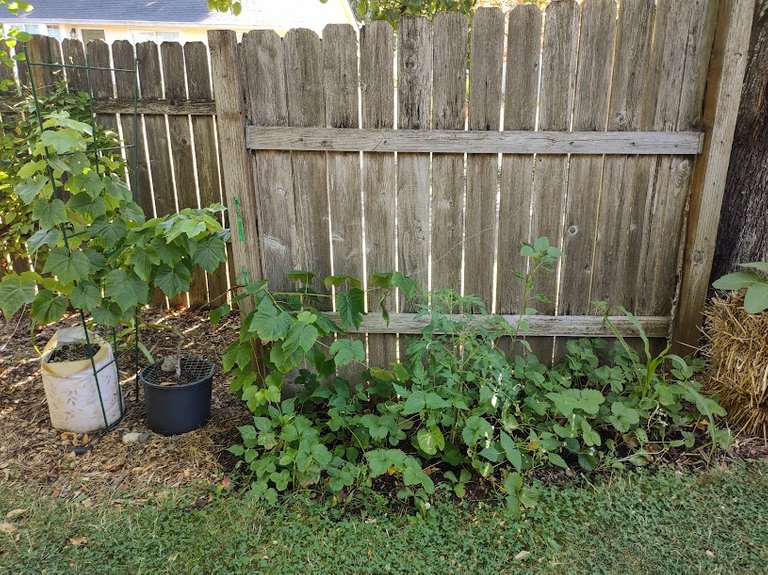
Conclusion
Here is what the vine looked like on the left, last summer.
I'll keep it growing here in the same spot, so it can use the trellis and fence to climb on.
As a bonus, I did manage to get one of my grape cuttings to root. If this cutting survives the winter cold, I'll likely be able to grow a sister grapevine plant, perhaps to train as a decorative bonsai tree.

Post Beneficiaries:
- 1% @cryptopie
This is my way of thanking each of you for your friendship and support. By sharing my talents on Hive, I can also share to help with your needs.
Let my success also grant you some happiness too.

I pot up my plants much the same way. Cool to se your method.
I have been planning to plant some local grapes in my vegetable, my problem is that I still have not decided to plant them. Whether I plant them inside my vegetable garden or around our house.